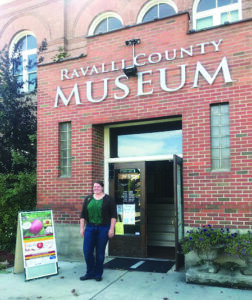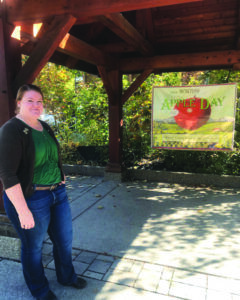
Two signature events take place each year at the Ravalli County Museum – Bitter Root Day in the spring and Apple Day in the fall. These events are uniquely tied to the valley’s history and coming up this weekend is Apple Day (and Liquid Apple Night) which will be celebrated on Saturday, October 1st.
Apple Day celebrates the cultural heritage of the valley, in particular the Apple Boom of the early 20th century.

The first apple trees in the valley were planted by Jesuit missionaries in the 1840s at St. Mary’s Mission at what is now Stevensville. According to a museum pamphlet about the Apple Boom compiled by William Whitfield, in 1866 Thomas W. Harris planted the first commercial apple orchard in the valley and by 1880, commercial apple production had reached 1000 bushels. In 1883 Stevensville held a Fruit Fair to celebrate the success of the apple industry, and in the 1890s, 10,000 fruit trees were shipped here from a nursery in Payette, Idaho. The Bitter Root Orchard Company had the largest apple orchard in the world at that time, with 40,000 trees on 380 acres of land. However, in 1898 a killing freeze destroyed two-thirds of the apple trees in the valley. There were still some big orchards, and in 1905, the valley produced 116,763 boxes of apples valued at $81,737. Construction of the Bitterroot Valley Irrigation Canal (the Big Ditch) was initiated. By 1906, there were over 374,000 apple trees on 3000 acres of land. In 1907, valley growers shipped 250 boxcar loads of apples out in 150,000 wooden boxes. The next year, the Bitter Root Irrigation Company contracted for 620,000 apple trees to be planted. Renowned architect Frank Lloyd Wright designed two local apple boom villages to promote the area as a place to purchase land and grow apple trees, University Heights in Darby and the town of Bitter Root north of Stevensville. (The Bitter Root Inn near Stevensville burned down in 1925 and the clubhouse at University Heights was dismantled in 1945.) By 1910, the Apple Boom was in full swing and the orchards did well until about 1922 when hail damaged most of the orchard crops and a late spring frost in 1924 froze the buds on the trees, decimating the crop. Three consecutive bad years brought a sudden end to the great Apple Boom of the Bitter Root. But the Apple Boom legacy remains, and is celebrated yearly at the Museum.
In preparation for Saturday’s big event, Museum volunteers have been baking 600 fresh apple pies. They spent two days at St. Francis Parish Hall, peeling apples and assembling pies. The pie crusts are made by Lou’s Pies, a popular local vendor at the farmers market. The pies are
baked at the Coffee Cup Cafe and the Corvallis School cafeteria. About 100 pies are frozen. All of them, both fresh and frozen, will be sold at Apple Day. They always sell out.
In addition to pies, apple butter, also made ahead of time by volunteers, is available for sale in pints and half pints. Apple butter is also made on site at the event and is available for purchase.
This is the 43rd annual Apple Day and, according to Michelle Nowling, Museum Director, this is the Museum’s biggest fundraiser of the year. She said it brings in about $30-$40,000 which helps with the Museum’s operating costs. Nowling said that a countywide mill levy only covers about a third of the museum’s budget, with the rest coming from grants and fundraising. The building is owned by the county, and some maintenance help is provided by county staff.
Nowling took over as director in April of 2021. She grew up in Philipsburg, went to college on the East Coast and worked in Utah before returning to the state in 2019. She has an undergraduate degree in American History and a Masters in Museum Studies. She said the museum averages about 8-9000 visitors annually, many of them repeat visitors. This year they’ve also had a number of people visit from out of the country, from places as far away as Costa Rica, Denmark and The Netherlands.

Apple Day will be the last chance to see the major exhibit, “Art & the History of Quilts” which was put together with help from the Heritage Quilters, a sub-group of the Bitterroot Quilters Guild. Coming next will be “Faces of Montana,” opening in mid-October. Nowling said that exhibit will be primarily comprised of photos from the Museum’s collection, plus a few objects. “It’s a broad representation of who settled here, and who came later,” said Nowling. She said many of the photos are unidentified and it’s possible that people might be able to identify some of them.

“Faces of Montana” is a lead-in to next year, when Ravalli County will be 130 years old. “We’ll have a special exhibit opening in March and running through the end of the year,” said Nowling. She said she’s working with the smaller museums in the county which will be sharing some items. Nowling said she’s also hoping to partner with other organizations for special activities throughout the year.

The Ravalli County Museum has recently been adding more outside exhibits so that even when the Museum is closed – which has been one of the casualties of staff shortages – people can still find something interesting to see. There are three permanent exhibits outside the Museum currently, one on the Nez Perce tribe, one on Glacial Lake Missoula, and the original historic marker from Ross’ Hole.
Something new at Apple Day, which runs from 9 a.m. to 3 p.m. and takes place on the streets adjacent to the Museum which is located at 205 Bedford in Hamilton, will be apple fritters made fresh by the Shooting Stars 4-H club. There are also about 160 vendors, live music, and a raffle that runs all day with the winners drawn at 2:30 p.m. Another raffle (for adults) will be held at Liquid Apple Night, which runs from 5 to 9 p.m. on the museum lawn, and also has live music, local hard cider, and food. Businesses have contributed many great items for both raffles.
“Our local businesses have been incredibly generous with raffle items,” says Nowling. “I’m really in awe of how the community supports this museum. It’s just amazing. I love it.”